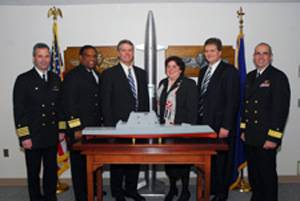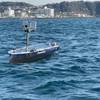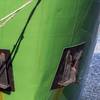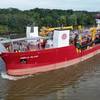DDG 1000: The Transformation Begins
“It isn’t everyday we get to sign a contract to begin construction of a lead ship, but on Feb. 14, we met in my office and did exactly that, twice! Not one but two lead DDG 1000 ships will now begin construction,” said Rear Adm. Vic Guillory, the director for Surface Warfare. “These 14,000-ton multi-mission warships represent tremendous new capability for the Navy and the surface combatant family of ships.”
Two identical lead ships will be built by Bath Iron Works (General Dynamics) and Ingalls (Northrop Grumman). Bath Iron Works will build DDG 1000 and Ingalls will build DDG 1001. Other prime contractors include BAE Systems and Raytheon. Delivery of the lead ship is expected in the late 2012 to early 2013 time frame.
Zumwalt (DDG 1000) is a multi-mission surface combatant which will provide a full spectrum of littoral dominance, tailored for persistent, all-weather volume fires and precision strike in the littorals. It will provide independent forward presence and deterrence, operating as an integral part of joint and coalition forces afloat and ashore, complimenting combined maritime forces across the warfighting missions of anti-submarine warfare, surface warfare, deep strike, and integrated air and missile defense.
A major focus of the DDG 1000-class will be joint fire support—the ability to destroy or neutralize enemy targets ashore with all-weather, day and night precision strike and volume fires,” says Guillory. “DDG 1000 will provide persistent, all-weather fire support to troops, answering 90 percent of calls for fire within five minutes using her two Advanced Gun Systems. Each of these systems will be able to deliver ten rounds per minute, at ranges in excess of 63 nautical miles. Two DDG 1000 ships will deliver approximately the same firepower as an artillery battalion ashore.”
Zumwalt will also deliver deep strike capabilities with Tactical Tomahawk cruise missiles launched from the 80-cell Advanced Vertical Launching System.
These ships will deploy independently or as part of a carrier or expeditionary strike group, and they are instrumental in laying the foundation for the fleet of the future. Navy force structure analysis determined that a DDG 1000 class size of seven ships is needed to provide forward presence and credible warfighting response in support of projected Major Combat Operations.
Guillory alluded to the fact that this moment was the culmination of nearly 14 years of analysis, PowerPoint slides, and long hours on the uniform side and with our industry partners. “All that has come together for this moment.”
The signing took place next to a model of DDG 1000. Across the room was a model of USS Constitution, a ship Guillory said also experienced challenges with budget and schedule. But, Guillory said, the “life cycle costs balanced out in the long run.”
DDG 1000 will possess a much improved capability to conduct area air surveillance, including over-land and throughout the sea-land interface. The dual band radar suite will combine the warfighting effects of both s-band and x-band radars. The S-band Volume Search Radar will provide improved detection of stealthy targets in the littoral environment, both near and at extended ranges. The X-band Multi-function Radar will detect and support engagement of advanced anti-ship cruise missile threats.
DDG-1000 will feature a pair of Advanced Gun System (AGS) guns to provide unprecedented offensive, distributed, and precision firepower at long range in support of Joint and Coalition forces ashore. AGS is a 155mm (6-inch), 62-caliber gun which will fire the Long Range Land Attack Projectile (LRLAP). The 7-foot long LRLAP round is a GPS-guided, rocket-assisted projectile with a range of up to 83 miles. With the AGS and LRLAP, DDG 1000 can provide long-range precision naval fires to support fast moving expeditionary forces far inland. LRLAP will expand the fire support area inland through the full range of Ship-to-Objective maneuver, covering the fire support gap until organic ground force artillery can be established ashore. LRLAP rounds have three times the explosive warhead of conventional 5-inch rounds. The AGS can fire four rounds at the same target with varied trajectories to arrive at the same point instantaneously.
Zumwalt will also deliver deep strike capabilities with Tactical Tomahawk cruise missiles launched from the 80-cell Advanced Vertical Launching System, an unmanned launching system capable of stowing, preparing, and launching a variety of missile types. Tactical Tomahawk missiles have 1,000 mile range and can be retargeted in flight.
Although a bigger ship than a DDG-51, Zumwalt has a smaller crew (148 including the aviation detachment), high quality of life and significantly lower total ownership costs.
DDG 1000 will have comprehensive signature control making it as quiet as a submarine and as small as a fishing boat on radar. DDG 1000 will be hard to find and harder to target.
DDG 1000 is an all-electric ship. Zumwalt’s Integrated Power System permits rapid reconfiguration of electricity and power distribution; allows for directed, high-energy and pulse-power weapons and powerful sensors beyond current power capabilities.
The complementary and interoperable mission capabilities of DDG 1000 and the Littoral Combat Ship (LCS), along with the next-generation multi-mission CG(X) cruiser, will satisfy the full spectrum of operational requirements demanded of the surface combatant force well into the 21st century.
“DDG 1000 is the Dreadnought of our Navy,” says Rear Adm. Chuck Goddard, the Program Executive Officer for Ships (PEO Ships), who is responsible for acquisition of DDG 1000. “For those of you who are historians Dreadnought is the ship that changed the British navy. It was a tough decision for them, and when they did it, they made the rest of the ships obsolete. But it also brought all new technology in terns of hull, propulsion and combat systems. Dreadnought was the first of the true battleships.”
“This program is representative of a great partnership with the Navy, says Brian Cuccias, Northrop Grumman vice president of DDG 1000. “The industrial base to build these fine ships will result in thousands of jobs.”
Dirk Lesko, vice-president and DDG 1000 program manager for Bath Iron Works, referred to the long process leading up to the construction contract as “lengthy but valuable. For Bath, this helps us continue120 years of shipbuilding history for the United States Navy.”
“Zumwalt is built for the littorals, and for the war on terror that we’re in today,” says Goddard. “I think it’s going to thrive in that environment.”













